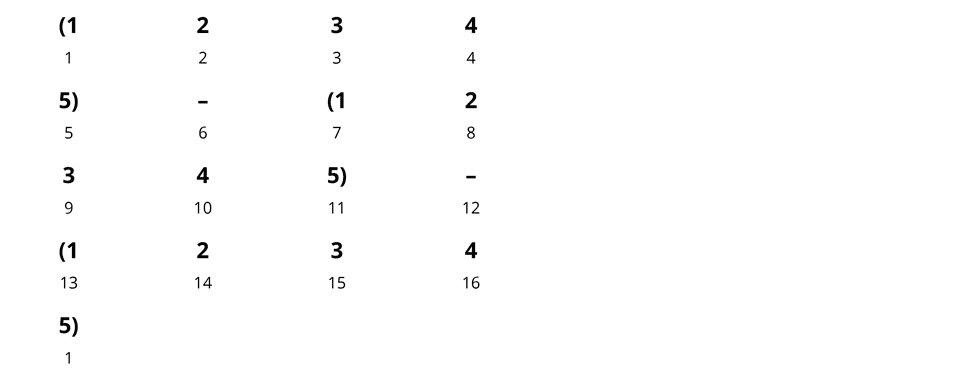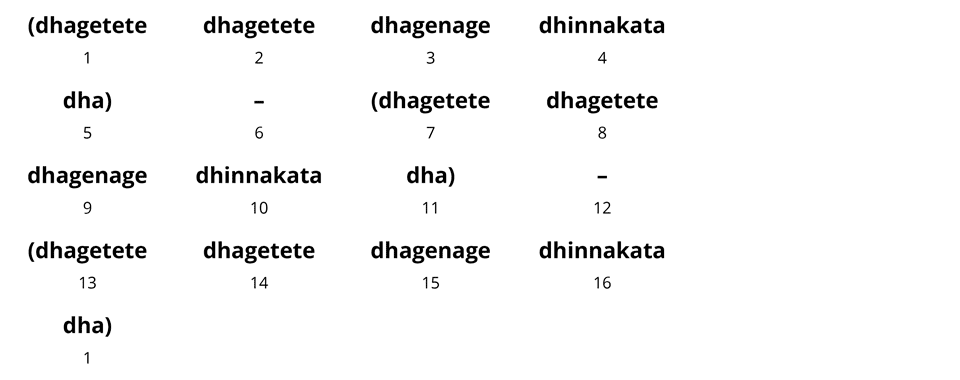Common Tihai Forms
Overview of the Common Tihai Forms
For each of the 5 major classical tals on this website, there is a page of common tihai forms:
- Common Tihai Forms in Tintal
- Common Tihai Forms in Rupak Tal
- Common Tihai Forms in Jhaptal
- Common Tihai Forms in Ektal
- Common Tihai Forms in Arachartal
The same tihai forms are given for each tal. They include:
- Sam-to-Sam Damdar Tihai
- Sam-to-Sam Bedam Tihai
- Sam-to-Sam Nauhakka/Chakradar Tihai
- Simple Chakradar
- Sadharan Chakradar
- Farmaishi Chakradar
- Kamali Chakradar
(Note: Links above are for tintal versions.)
For any tal, there are many, many possible tihais. But these forms are especially common for classical tabla students. At India’s universities and music institutes, students are often tested on these forms, in both practical and written exams.
Chhotelal Misra focused on these particular forms in his books. Most notably, a book about Benares mukhra (compiled by Chhotelal’s student Prem Narayan) which focuses exclusively on these forms, with many examples in 11 different tals.
Are these forms standards?
Some of these forms are so common that we can call them standards. The following forms in particular are generally the same from player to player, and gharana to gharana:
Most of the other forms are also common, but there are many variations for the same form (discussed below), except for the farmaishi and kamali which allow only slight variations.
So the particular mukhra-tihai divisions in the examples are not necessarily standards. But they are common combinations.
Tihai Variations
For most of these tihais and chakradars, there are many possible variations for their internal structures, while keeping the same overall math. For the larger chakradar forms especially, there are many different ways of combining an opening section (mukhra) with a tihai to arrive at the same number of matras.
The forms here show some of the most common structures and, as much as possible, the simplest ways of getting from point A to point B. These will hopefully be the easiest to memorize. Students can then more easily learn and understand many other forms with the same overall math, but with different internal structures.
About the Structures
Each tihai and chakradar includes a diagram of its structure. “Structure” means how many matras (beats), or sub-matras, there are in each part, and how long the pauses are (if any).
For example, the sam-to-sam damdar tihai in tintal has the following structure:

This shows that each repetition of the tihai is 5 matras long, and there is a 1-matra pause between each repetition (total of 2). So the math for this tihai would be:
5 x 3 = 15 + 2 = 17
The reason for showing each form’s structure is to help students learn the underlying structure of any tihai, tukra, or chakradar, and not just memorize particular examples. That way, students can create their own versions of the same structure.
For example, the structure above could be filled with a 5-matra phrase of 2 strokes per matra:

Or it could be filled with a different 5-matra phrase, in this case 4 strokes per matra:

About the Math
The math for each tihai is given for more serious students. Not everyone will need to learn the math for each form that they learn to play, and some forms can be memorized without learning the math. But the more math you understand the better.
Advanced beginners and non-professional tabla players should understand the math for at least the most common forms in tintal. These include:
Listeners don’t need to learn much about the math if they don’t want to (though a little math can be very helpful in understanding the classical system). But you should become familiar with at least the 3 most common forms in tintal mentioned above.
References
Misra, Chhote Lal. Tal Prabandh New Delhi: Kanishka Publishers, 2006. (Hindi)
—. Tabla Granth. New Delhi: Kanishka Publishers, 2006. (Hindi)
Singh, Prem Narayan. Banares Gharana ke Tabla-Vadan me Mukhra New Delhi: Kanishka Publishers, 2009. (Hindi)